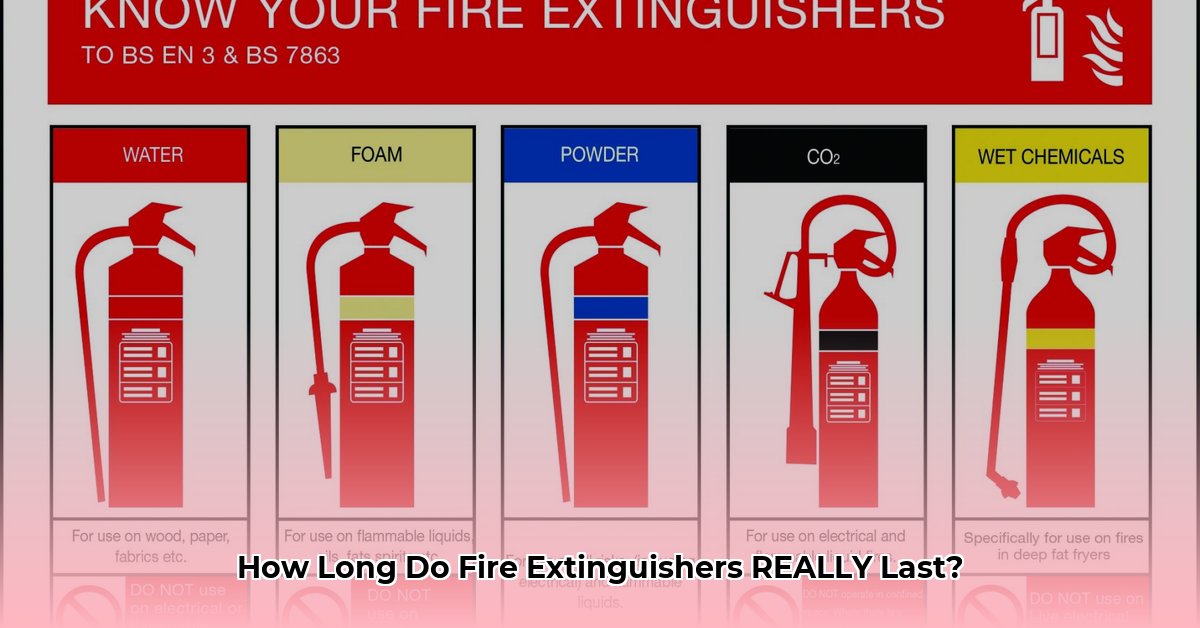Fire extinguishers are essential safety tools, but they don’t last forever. Like any piece of safety equipment, they require regular maintenance and eventual replacement. This guide provides a comprehensive overview of fire extinguisher lifespans, inspection procedures, maintenance tips, and proper disposal methods, empowering you to keep your home or workplace safe.
Know Your Extinguisher: Types and Lifespans
Different fire extinguishers are designed for different types of fires, and their lifespans vary accordingly. Here’s a breakdown:
| Extinguisher Type | Typical Lifespan | Recharge/Hydrostatic Test | Important Notes |
|---|---|---|---|
| Disposable | 10-12 years | Not Applicable | These are one-and-done. Discard after any use, even a small discharge, or when they expire. |
| Water (Pressurized, Mist) | 5-12 years (depending on the specific type) | Every 6 Years; Hydrostatic Testing Varies depending on design | Check your owner’s manual—specifics on pressure testing can vary. |
| Wet Chemical | 5-6 years | Every 6 Years; Annual Checkup | These require more frequent attention. |
| Carbon Dioxide (CO2) | Potentially 10+ years* | Every 5 Years (after the first decade) | *The manufacturing date is crucial. Refurbishment may eventually be needed. |
| Dry Chemical (Standard) | Around 6 years | Every 6 Years; Annual Checkup | Refill and clean after every use, even a small one. |
| Dry Chemical (Potassium Bicarbonate, or “Purple K”) | Around 12 years | Every 6 Years; Annual Checkup | Like standard dry chemical extinguishers, clean and refill after any discharge. |
| Clean Agent/ Halogen Replacement | 12 years | Every 6 years | Should be replaced after use, even a small one. |
| P50 Service-Free Wheeled | Up to 20 Years | Recharge and hydrostatic test every 12 years | For Commercial use, “Service-free” doesn’t mean “inspection-free”! Still, give it a regular once-over. |
If you’re unsure about your extinguisher type or its maintenance needs, consult a fire safety professional.
Inspecting Your Fire Extinguisher: A Monthly Routine
Regular inspections are crucial for ensuring your fire extinguisher is ready when you need it. A quick monthly check is all it takes:
- Pressure Gauge: Ensure the needle is in the green zone, indicating adequate pressure.
- Visual Inspection: Look for signs of damage like rust, dents, or corrosion.
- Hose and Nozzle: Check for cracks or blockages in the hose and nozzle.
- Tamper Seal: Verify the tamper seal is intact, showing the extinguisher hasn’t been used.
- Accessibility: Make sure the extinguisher is easily accessible and not obstructed.
Maintaining Your Fire Extinguisher: Beyond the Basics
While monthly inspections are important, professional maintenance is also necessary:
- Annual Professional Inspection: Schedule an annual inspection by a certified technician.
- Six-Year Internal Maintenance (Rechargeable Only): Every six years, rechargeable extinguishers require internal inspection and servicing.
- Hydrostatic Testing: Extinguishers undergo hydrostatic testing every five to twelve years, depending on the type, to ensure the cylinder can withstand internal pressure.
Recharge vs. Replace: Making the Right Call
Knowing when to recharge or replace an extinguisher is key:
Recharge: Necessary after any use, if the pressure is low, or as recommended during maintenance.
Replace: If the extinguisher is expired, damaged, or fails hydrostatic testing, replacement is necessary. Consider replacing older extinguishers even if they’re still functional, as newer models may offer improved safety features.
Disposing of Your Fire Extinguisher Responsibly
Proper disposal is crucial. Contact your local fire department or waste disposal service for guidance, as regulations vary. Never simply throw an extinguisher in the trash.
Frequently Asked Questions (FAQ)
Q: Where can I buy a fire extinguisher?
A: Fire extinguishers are available at most hardware stores, home improvement centers, and online retailers.
Q: What type of fire extinguisher do I need for my home?
A: A multi-purpose (ABC) dry chemical extinguisher is generally recommended for homes, as it’s effective against Class A (ordinary combustibles), Class B (flammable liquids), and Class C (electrical) fires. For kitchens, a Class K extinguisher specifically designed for grease fires is recommended in addition to an ABC extinguisher.
Q: What is the difference between inspection and maintenance?
A: Inspection is a visual check you can perform monthly to look for obvious signs of damage or low pressure. Maintenance is performed annually by a professional and involves a more thorough assessment and any needed repairs or recharges.
The Future of Fire Extinguishers
Ongoing research and technological advancements may likely change recommendations for fire extinguisher types, lifespans, and maintenance in the future. Stay informed about new developments to ensure optimal fire safety.
By following these guidelines and staying informed, you’re taking proactive steps to protect yourself, your family, and your property. Remember, a functional fire extinguisher is a vital component of your overall fire safety plan.
- Post 1 - October 30, 2025
- Enterprise Mobile App Development: How To Measure Room Temperature - October 14, 2025
- Google CBS Mobile App: Is CBS Charging Mobile Users? - October 13, 2025









